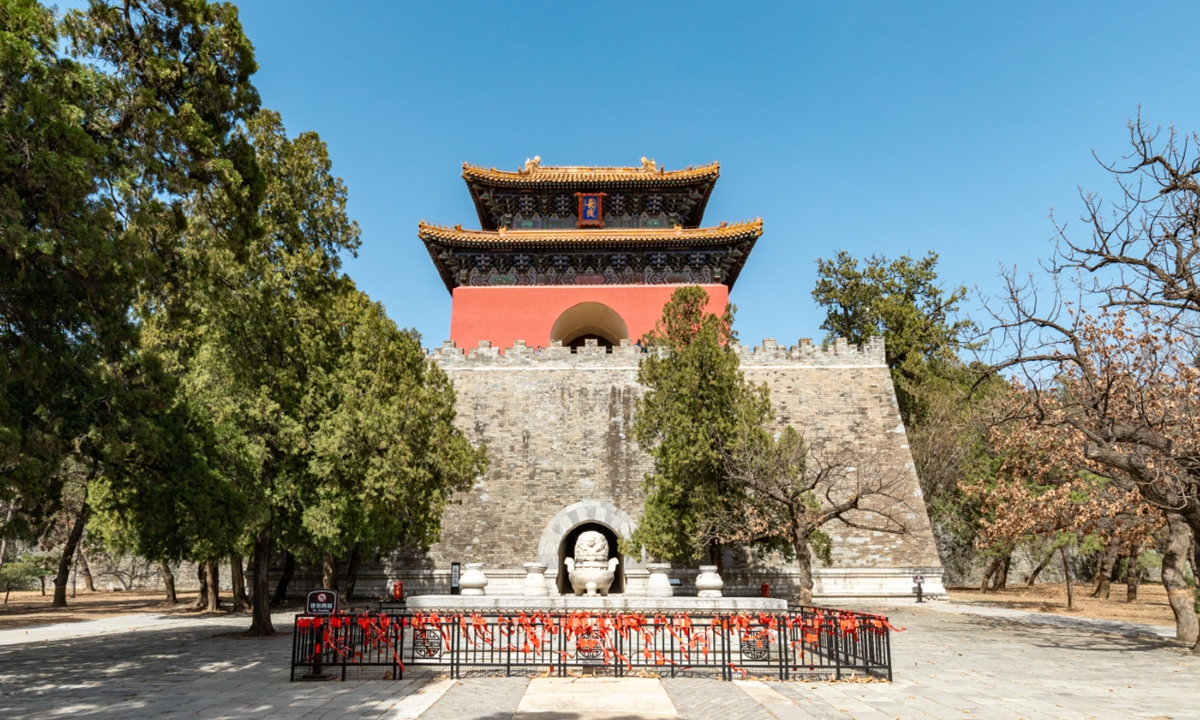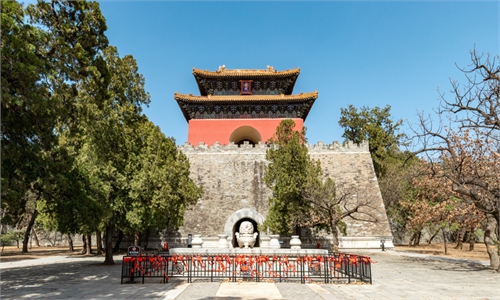ARTS / CULTURE & LEISURE
Tomb of Shu Kingdom lord from Ming Dynasty rediscovered in Chengdu

Ming Tombs Photo: VCG
The tomb of a noble was recently rediscovered in Chengdu, Southwest China's Sichuan Province. With intricate designs, the tomb once belonged to a "feudal lord who was enfeoffed by the Hongwu Emperor, Zhu Yuanzhang," Xie Tao, an archaeologist on the excavation project, told the Global Times.
The feudal lord who owned the tomb was called Zhu Xuanqi. He was the 11th-generation lord of the Shu Kingdom during the Ming Dynasty (1368-1644) in what is now Sichuan Province. The noble also had the posthumous title of "King of Duan," or the "King of Uprightness."
A highlight of the excavation is a four-character stone-carved couplet inscribed with the Chinese characters Zhongxian, Maozhu, which roughly translates to "exemplary loyalty and virtue." Xie told the Global Times that this tablet served as a "commendation" of the King of Duan. Besides this, a tombstone was also discovered engraved with "the Tomb of Consort Shi."
"Among all the feudal lords of the Shu Kingdom, only Zhu Xuanqi's consort had the surname Shi," said Xie, adding that the discovery has helped experts confirm the tomb owner's identity.
Although smaller in scale compared to previously discovered Shu King tombs, this newly unearthed burial site is of much higher grade. The site comprises three tombs: the central main tomb flanked by consort tombs on either side.
The main burial chamber stretches over 12 meters in length and consists of four sections, including an antechamber, central chamber, rear chamber, and coffin chamber. This burial configuration reflects not only the tomb's highgrade, but also the "important role of feudal lords during the Ming Dynasty," historian Zhou Xueying told the Global Times.
"Ming Dynasty feudal lords wielded significant authority within their domains. The lord of the Shu Kingdom held particular prominence since the emperor Zhu Yuanzhang, the first emperor of the Ming Dynasty, was very focused on the region due to its importance in military defense," Zhou told the Global Times.
The walls of the tombs' chambers were engraved with dragon reliefs, intricate carvings replicating traditional architectural elements such as roof ridges, eaves tiles, and chiwen ornaments, a type of mythical dragon that is commonly seen at both ends of a roof in ancient Chinese architecture.
Noting such architectural elements are more commonly seen on buildings used by the living, Xie said that their presence in the tombs reveal the Ming people's burial belief of "treating the deceased with the same respect as the living."
"However, we also noticed that the tomb's size is small. We believe that this likely reflects the declining social growth of Zhu's era in the late Ming Dynasty. It has affected the economy back then and also led to Zhu's mausoleum being drastically reduced in size.
Zhu's tomb "disappeared" for a time. It was first discovered in the 1990s, when archaeologists recovered artifacts such as pottery figurines from the area. However, subsequent road network changes and land reclamation in the area altered the terrain, eventually burying the site. After more than 30 years of time, the recent rediscovery was made possible by the ongoing fourth national survey of cultural relics, which is scheduled to conclude in June 2026.
Chengdu has always been the cradle for tombs of multiple Shu feudal lords. In the city's Longquanyi district, a tomb cluster of Shu feudal lords featuring nobles such as the lord of Xi, Huai, Hui and Zhao has been found. Lord Xi's tomb is the most exquisite one, with stone-carved elements and cutout reliefs.
Meanwhile, on the city's Fenghuangshan, also known as Phoenix Mountain, lies the tomb of Zhu Yuelian, the grandson of the dynasty's founder Zhu Yuanzhang. The tomb was decorated with a large number of glazed tiles and gold material embellished stone carvings, revealing the advanced artistry of Ming-era tomb design.
"These tombs have helped us to study the history of the Shu regime, extending its cultural narratives to enrich today's Shu culture," Zhou noted.



